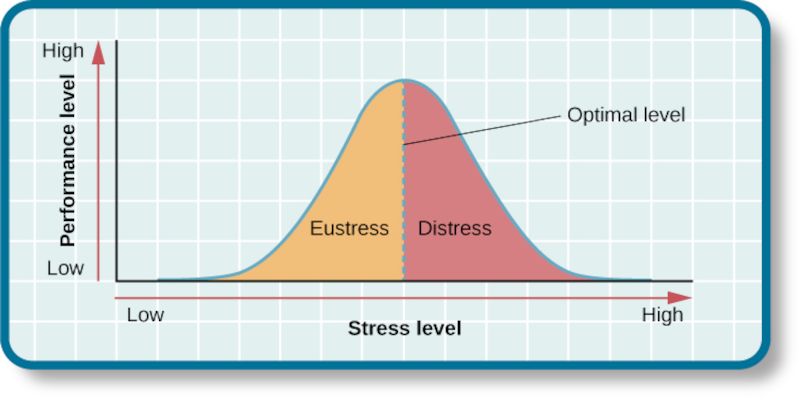Table of Contents
ToggleSummary:
- Fear can be a powerful short-term motivator.
- It can make us change our behavior for the better.
- Dread is not a healthy long-term incentive.
- Being slightly frightened can increase productivity.
- Being too scared decreases productivity.
Make sure the fear isn’t too overwhelming

Psychology teaches us that fear can be a powerful motivator if that negative emotion isn’t too overwhelming.
It’s a delicate balance because, on one hand, the discomfort needs to be strong enough so that we’re incited to induce a change, yet it shouldn’t be so intense that we’re paralyzed by fright.
We know that experiencing an overbearing amount of stress decreases our productivity while creating more, and more intense, negative emotions. That’s exactly what we’re trying to prevent here because that will only be detrimental to our fruitfulness and personal well-being.
Figure out why you’re afraid
Uncomfortable sensations such as pain and fear are attempts of our body to tell us something by basically begging us to listen. And fearfulness means we’ll have to alter our actions to reduce these awkward sentiments.
But that’s hard if you don’t know why you’re terrified, or how you must modify your behavior to make the uncomfortableness go away, or at the very least decrease in severity.
So one of the first steps is figuring out why you’re scared, whether that fear is sensible or not, and what will happen in the future if we don’t do anything to change our present ways.
Own your fear

Instead of desperately trying to hide your anxiety, or trying to act like it doesn’t exist, own the fact that you’re feeling that naturally occurring emotion. That’s no shame since everyone’s bound to encounter fright at some point in their lives.
You’re only able to change your fate when you’re capable of accepting that you’re fearful and that you need to switch things up if you wish to avoid these sensations in the future.
That’s simply not possible when we’re too busy denying and concealing the fact that we’re scared of something.
What’s the goal you want to achieve
While the goal is probably trying to reduce awkward sensations, it’s most likely also related to an end you’re seeking to achieve in life. A higher purpose, so to speak.
For instance, we might want to stop being socially anxious when interacting with strangers to quit feeling awkward and uncomfortable. But the overarching goal in your existence might be to improve your social skills by talking to those around you, and to stop feeling judged all the time.
Simply eliminating the fear is too shallow of a goal. We need to know the true, and full extent of what that concern is trying to tell us to prevent it from resurfacing down the road.
Make plans to change

Blindly winging a solution is a surefire way to end in disaster instead of taking the time to create a proper plan of action that takes into account possible hurdles, and what you’re searching to achieve.
You need to realize what steps you need to take before you can reduce your anxiousness, which entails fully understanding what the issue is, and why you’re feeling that way.
Analyze potential hurdles
Life is filled with hurdles, and getting rid of fear is no different. Because if it was easy, everyone would do it.
And that’s why a lot of people continue to experience fear without ever truly fixing the problem. It’s a lot more convenient trying to act like nothing’s wrong by ignoring the issue, but that’s only going to make matters worse in the end.
Decipher what’s going to be hard for you to change, and what can go wrong when trying to alter your conduct. We’re only human after all, and that automatically means that lots of things can, and will probably go haywire.
Eliminate obstacles

Writing down the pros and cons of your plans, and achieving your objectives can aid in targeting actual, or imaginary issues.
While we’re inclined to feel negative emotions more strongly, it’s important to analyze the probability that these unfavorable events are going to end up happening. Because we often suffer more in imagination than reality, which means we usually think things are going to go worse than they do.
Put your plan into action
Act out what you’ve been preparing to do all along. This is the hardest part since talk is cheap, but adjusting something we’ve been doing for a long time is extremely challenging. We’re creatures of habit, much more so than we realize most of the time.
Still, you can do it. Believe in yourself, and try to follow the schedule you’ve put so much time and effort into beforehand. But don’t become mentally inflexible, either. When you notice that your plan isn’t perfect, or that you can improve some things on the spot, then you should do so.
Evaluate your results
Did the system work according to plan? Are you satisfied with the outcomes of your modified behavior?
If the answer is yes, then good job! You’ve reduced your fear and achieved your goal by altering your conduct.
If not, don’t despair. Just because something didn’t work out the way we wanted doesn’t mean it wasn’t effective at all. Attempt to revise your plan to suit your ends, and to get rid of the worry that’s been bothering you once and for all.
Frequently Asked Questions (FAQ)
Why is fear a good motivator in the short term?

While fear is typically seen as a negative, uncomfortable emotion, it is also one of the most powerful motivators since we’re more driven to prevent painful experiences rather than chasing positive emotions.
While leading by fear isn’t recommended, and can only work briefly, Uneasiness can work as a motivator if, and only if there’s a solution that goes along with it.
Here’s why being afraid can work as a motivator:
Heightened senses
You’re more mindful when you’re anxious because of your increased mental alertness.
Be wary, though, since that means that being too frightened will make you less productive since your senses get overloaded. That’s why being slightly fearful, but not overly alarmed, is preferred to increase productivity. Unfortunately, that’s such a difficult balance to achieve and maintain.
Being more aware of your surroundings, your actions, and what to change allows you to alter certain conducts to achieve your dreams.
Increased perseverance

It’s easier to persevere when you’re afraid of the potential consequences if you were to quit. A purpose typically guides our behavior. Thinking rationally, it makes sense that we wish to avoid agonizing, negative sensations by getting rid of the thing(s) that make us scared.
That’s the perfect motive to adjust what we’re currently doing to reduce our anxiety since nobody likes feeling uneasy. Still, learning to embrace uncertainty and some nervousness is essential since they’re both critical components of life, and normal when venturing into new, unexplored territories.
There are two types of motivation that we can use to explain our behavior:
Intrinsic/internal motivation
Intrinsic motivation comes from within us. We feel impelled because we’re doing something meaningful to us. After all, it matches our personal beliefs, values, and interests.
An example is volunteering to help those in need, or playing a sport because you enjoy it, rather than doing so just to win trophies.
Extrinsic/external motivation

Illustration depicting the differences between intrinsic and extrinsic motivation. Extrinsic motivation comes from the outside world, meaning we’re inspired because of an external reward, or to avoid punishment, which can be seen as a reward in itself.
An illustration of extrinsic motivation at play is working overtime because we’re afraid we’re going to get fired, or demoted at work. Another possible instance is playing sports solely to win trophies, instead of doing so because you like it.
While both can be viable, and strong motives, external impulses typically don’t last as long since they’re temporal, and because we don’t find them as meaningful as internal incentives.
What we can say is that we’re more motivated when we can gain an immediate reward, rather than gaining a larger, yet delayed gratification. Nevertheless, learning to delay the desire for instant gratification is one of the key factors to become successful.
Why is fear not a good motivator in the long term?
Decreased productivity

Our productivity will start to decrease instead of grow when we’re overpowered by the amount of stress we’re going through. It’s possible that we can offset this damaging aspect by preventing the fear from becoming too large and domineering, although it’s a very tricky balance to conserve.
It’s better to use positive incentives that we find influential as long-term encouragements to exhibit certain behaviors since that’s not going to increase our tenseness all that much.
Furthermore, our instinct is to avoid, or ignore, situations that instill anxiety and discomfort in an attempt to decrease the mental strain we experience. Even though that doesn’t resolve the issue, this phenomenon can lead to developing avoidance behavior, which causes even more problems in the end.
Too stressful
Being under constant pressure for too long increases our cortisol levels. That’s our stress hormone and is normally only a part of the fight or flight response to make us more alert and responsive to the threat at hand.
The liability is that it’s a highly taxing state, and will wreak havoc on our body if prolonged. That’s why chronic stressors and anxiety-provoking situations such as being fearful for a long time are discouraged. They’re incredibly unhealthy for our physical and mental wellbeing.
Creates negative thinking

Being too aware can make us overly self-critical, to the point of destroying our self-worth.
We’re also more likely to suffer from intrusive thoughts, such as notions that something bad is going to happen, or that things will inevitably go wrong. And while that most certainly isn’t always true, being too conscious of everything might make it seem that way.
What is fear motivation?
How does fear motivation theory work?

Threat appraisal
Threat appraisal means measuring how much fear and anxiety one experiences because of the perceived intensity of the threat(s)
Coping appraisal
Coping appraisal stands for 3 separate collections of thoughts.
We must believe that a behavioral change will reduce or eliminate the threat.
We must conceive that we are capable of adjusting our conduct.
Not only that, but we must assume that the cost associated with our new, changed demeanor isn’t higher than not altering our actions and facing the threat as a result.
An example of using fear as motivation
For instance, if you know that you need to overcome your nervousness about public speaking to qualify for a promotion, your fear of missing out on that promotion has to be greater than your dread of public speaking.
While this theory is similar to fear motivation, the employee doesn’t remain in a stressful, fear-induced state forever. They overcome their worries or move past them to reach a healthier place eventually.
Final note

Fear is a good motivator in the short term, yet often starts working against us when prolonged. That’s because it causes a lot of mental strain that reduces productivity as a consequence.
Still, just because it’s considered a negative emotion doesn’t mean that it doesn’t have any utility, or that it can’t aid us to improve our situation. That’s made possible by stimulating us to change our circumstances to prevent sensing that uncomfortable feeling again.







